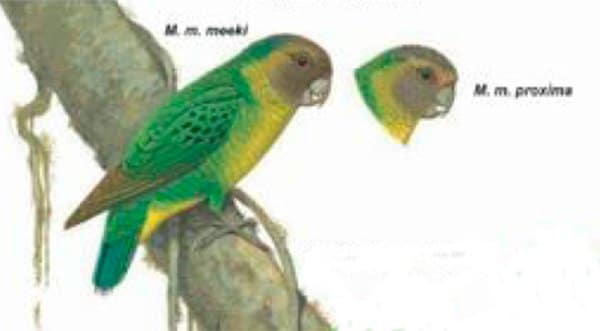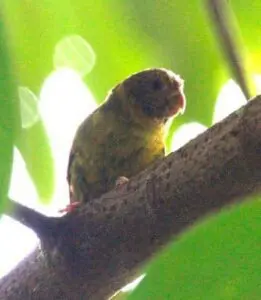Content
|
|---|
Description
10 cm. length.
The Meek's Pygmy-Parrot (Micropsitta meeki) has the feathers of the head dark brown, strongly scalloped in color yellow on them ear-coverts and the sides of the throat, and usually with the eyebrows in a vague color yellow; feathers of the crown with fine greyish yellow tips.
Upperparts dark green, darker on the margins and the Center to the Middle coverts black. Feathers primary Black with green trim; secondaries mainly green. Wing feathers more dark with the tips of color yellow; underside of flight feather blackish. Top of the chest and centre of belly, opaque yellow, with brown spots at the tips of the feathers; flanks color green dark; under the tail, coverts yellow. Tail greenish blue in the Center, feathers laterales blackish with stains yellow on the tips or with pointed blue and yellow.
Bill yellow rose pale; irises yellowish brown; legs Pink.
Similar to males females.
- Sound of the Meek's Pygmy-Parrot.
Subspecies
-
(Rothschild and Hartert, 1914) – The nominal.
Micropsitta meeki meeki
-
(Rothschild and Hartert, 1924) – The face is more pale and the grey more beige that the of the nominal species; light diffusion of greenish color instead of the yellow markings of the nominal, and a band front yellow with find in them eyebrows.
Micropsitta meeki proxima
Habitat:
Not well known. It occurs in forests, high secondary growth, and even in trees around inhabited areas. The birds are found in small groups. Habits are like those of the Buff-faced Pygmy-Parrot.
Reproduction:
The nest they usually build it on a tree termite mound, Sometimes it can be very close to the ground.
Food:
They feed on lichens and fungi collected from trunks of trees.
They nourish also of seeds, nuts, berries and fallen fruits that they can find, Although they prefer to eat fruits of plants. They also feed on insects and insect larvae.
Distribution:
Size of the area of distribution (reproduction / resident): 2,400 km2
Endemic to the forests of the lowlands, until 700 meters of altitude on the Islands in the Northwest Bismarck Archipelago including Manus, Lou and Rambutyo in the Group of Admiralty and Mussau and Emira in the Saint Matthias group.
Of the two subspecies:
-
The nominal
Micropsitta meeki meeki
-
Present in the san matias islands (Mussau, Eloaua, Emirau).
Micropsitta meeki proxima
Conservation:
• Current IUCN Red List category: Least concern
• Population trend: Stable
The size of the world population It has not been quantified, It is thought that it may be above the 10,000 specimens. According to sources, the species is common both in Manus as Lou (pit et to the. 1997).
The population is suspected to be stable in the absence of evidence of any reduction or substantial threats.
"Meek's Pygmy-Parrot" in captivity:
Not found in captivity.
While attempts have been made to keep Pygmy parrots in captivity, These have not been successful. This may be due to the fact that birds suffer from stress or a lack of understanding of their dietary needs.
Alternative names:
– Meek’s Pygmy-Parrot, Citrine Pygmy Parrot, Meek’s Pygmy Parrot, Yellow-breasted Pygmy Parrot, Yellow-breasted Pygmy-parrot (ingles).
– Micropsitte de Meek (French).
– Meekspechtpapagei, Meek-Papagei (German).
– Micropsitta meeki (Portuguese).
– Microloro de Meek (español).
scientific classification:
– Order: Psittaciformes
– Family: Psittaculidae
– Genus: Meeki
– Scientific name: Micropsitta meeki
– Citation: Rothschild & Hartert, 1914
– Protonimo: Micropsitta meeki
Images "Meek's Pygmy-Parrot"
————————————————————————————————
“Meek's Pygmy-Parrot” (Micropsitta meeki)
Sources:
– Avibase
– Parrots of the World – Forshaw Joseph M
– Parrots A Guide to the Parrots of the World – Tony Juniper & Mike Parr
– Birdlife
– Photos:
(1) – Parrots of the World – Forshaw Joseph M
(2) – Meek’s Pygmy-Parrot on Manus – BIRDING AROUND THE WORLD
– Sounds: Frank Lambert (Xeno-canto)



